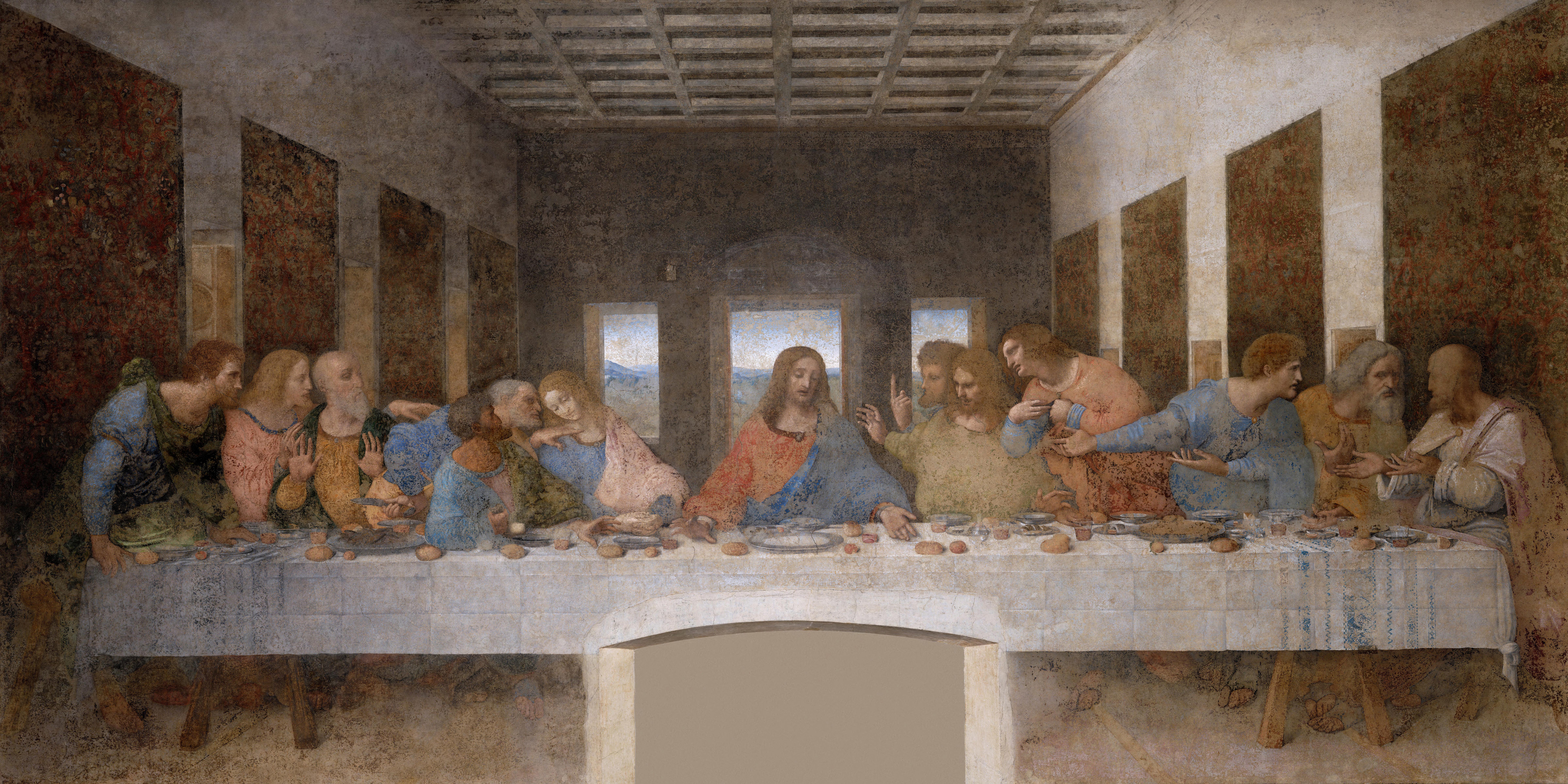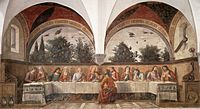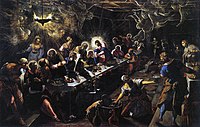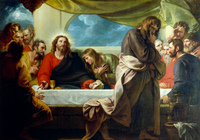
Last Supper
The Last Supper is the final meal that, in the Gospel accounts, Jesus shared with his apostles in Jerusalem before his crucifixion.[2] The Last Supper is commemorated by Christians especially on Holy Thursday.[3] The Last Supper provides the scriptural basis for the Eucharist, also known as "Holy Communion" or "The Lord's Supper".[4]
For other uses, see The Last Supper (disambiguation).
The First Epistle to the Corinthians contains the earliest known mention of the Last Supper. The four canonical gospels state that the Last Supper took place in the week of Passover, days after Jesus's triumphal entry into Jerusalem, and before Jesus was crucified on Good Friday.[5][6] During the meal, Jesus predicts his betrayal by one of the apostles present, and foretells that before the next morning, Peter will thrice deny knowing him.[5][6]
The three Synoptic Gospels and the First Epistle to the Corinthians include the account of the institution of the Eucharist in which Jesus takes bread, breaks it and gives it to those present, saying "This is my body given to you".[5][6] The Gospel of John tells of Jesus washing the feet of the apostles,[7] giving the new commandment "to love one another as I have loved you",[8] and has a detailed farewell discourse by Jesus, calling the apostles who follow his teachings "friends and not servants", as he prepares them for his departure.[9][10][11]
Some scholars have looked to the Last Supper as the source of early Christian Eucharistic traditions.[12][13][14][15][16][17] Others see the account of the Last Supper as derived from 1st-century eucharistic practice as described by Paul in the mid-50s.[13][18][19][20]
In Islam
The fifth chapter in the Quran, Al-Ma'ida (the table) contains a reference to a meal (Sura 5:114) with a table sent down from God to ʿĪsá (i.e., Jesus) and the apostles (Hawariyyin). However, there is nothing in Sura 5:114 to indicate that Jesus was celebrating that meal regarding his impending death, especially as the Quran states that Jesus was never crucified to begin with. Thus, although Sura 5:114 refers to "a meal", there is no indication that it is the Last Supper.[86] However, some scholars believe that Jesus' manner of speech during which the table was sent down suggests that it was an affirmation of the apostles' resolves and to strengthen their faiths as the impending trial was about to befall them.[87]
Historicity
According to John P. Meier and E. P. Sanders, Jesus having a final meal with his disciples is almost beyond dispute among scholars, and belongs to the framework of the narrative of Jesus' life.[88][89] I. Howard Marshall states that any doubt about the historicity of the Last Supper should be abandoned.[14]
Some Jesus Seminar scholars consider the Last Supper to have derived not from Jesus' last supper with the disciples but rather from the gentile tradition of memorial dinners for the dead.[90] In their view, the Last Supper is a tradition associated mainly with the gentile churches that Paul established, rather than with the earlier, Jewish congregations.[90] Such views echo that of 20th century Protestant theologian Rudolf Bultmann, who also believed the Eucharist to have originated in Gentile Christianity.[19][20]
On the other hand, an increasing number of scholars have reasserted the historicity of the institution of the Eucharist, reinterpreting it from a Jewish eschatological point of view: according to Lutheran theologian Joachim Jeremias, for example, the Last Supper should be seen as a climax of a series of Messianic meals held by Jesus in anticipation of a new Exodus.[91] Similar views are echoed in more recent works by Catholic biblical scholars such as John P. Meier and Brant Pitre, and by Anglican scholar N.T. Wright.[92][17][93]
The Last Supper has been a popular subject in Christian art.[1] Such depictions date back to early Christianity and can be seen in the Catacombs of Rome. Byzantine artists frequently focused on the Apostles receiving Communion, rather than the reclining figures having a meal. By the Renaissance, the Last Supper was a favorite topic in Italian art.[94]
There are three major themes in the depictions of the Last Supper: the first is the dramatic and dynamic depiction of Jesus's announcement of his betrayal. The second is the moment of the institution of the tradition of the Eucharist. The depictions here are generally solemn and mystical. The third major theme is the farewell of Jesus to his disciples, in which Judas Iscariot is no longer present, having left the supper. The depictions here are generally melancholy, as Jesus prepares his disciples for his departure.[1] There are also other, less frequently depicted scenes, such as the washing of the feet of the disciples.[95]
The best known depiction of the Last Supper is Leonardo da Vinci's The Last Supper, which is considered the first work of High Renaissance art, due to its high level of harmony.[96]
Among other representations, Tintoretto's depiction is unusual in that it includes secondary characters carrying or taking the dishes from the table,[97] and Salvador Dali's depiction combines the typical Christian themes with modern approaches of Surrealism.[98]
Music
The Lutheran Passion hymn "Da der Herr Christ zu Tische saß" (When the Lord Christ sat at the table) derives from a depiction of the Last Supper.














